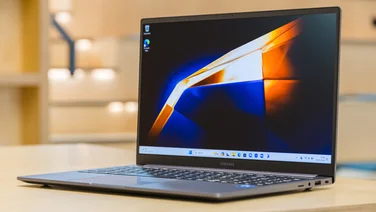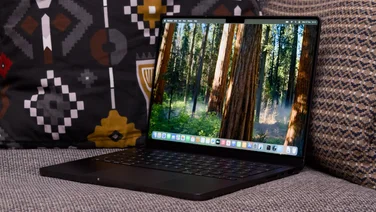To help us provide you with free impartial advice, we may earn a commission if you buy through links on our site. Learn more
- Best laptops: At a glance
- How we test laptops
- The best laptops you can buy in 2025
- 1. Apple MacBook Air (M4, 2025): Best laptop overall
- 2. Microsoft Surface Laptop 7: Best Windows laptop
- 3. Asus Chromebook Plus CX34: Best laptop under £500
- 4. Acer Chromebook Spin 714: Best budget laptop
- 5. Asus Zenbook S 14 (UX5406): Best Intel ultraportable
- 6. Asus Vivobook S 15 (S5507): Best 15in laptop
- 7. Acer Swift AI 14: Longest battery life
- 8. Lenovo Legion Slim 5 Gen 8: Best compact gaming laptop
- 9. Samsung Galaxy Book4 Pro 360: Best 2-in-1 laptop
- How to choose the best laptop for you

If you’re after the best laptop money can buy, you’ve come to the right place. We’ve collected all of the best laptops in one place to help you find the perfect machine for your needs in 2025.
Wondering why you should listen to us? Simple. Every year, dozens of the latest and greatest laptops pass through the Expert Reviews labs – along with plenty of not-so-great laptops, too. Each device is subjected to our rigorous in-house testing, so when we recommend a laptop you can be sure of one thing: it’s a laptop we would be happy to buy ourselves.
Best laptops: At a glance
| Best laptop overall | Apple MacBook Air 13.6in (M4, 2025) | |
| Best laptop under £500 | Acer Chromebook Plus CX34 | |
| Best windows laptop | Microsoft Surface Laptop 7 |
How we test laptops

We have decades of experience reviewing laptops here at Expert Reviews but we still put every laptop through a series of demanding tests.
That way we can be sure we’re being as objective as possible in our assessment of each laptop sent in for review.
To do that, we spend hours testing and using every machine that is sent in, mixing synthetic and real-world tests to get an overall view of a system’s performance:
- We run our own in-house benchmarking software – this pushes the system as a whole, stressing the CPU, GPU and cooling system all at once
- We run a whole host of third-party benchmarking applications, including Geekbench, Cinebench, GFXBench, AS SSD and GPU/games-focused benchmarks, so you can compare your laptop with the systems we test
- We test the brightness, contrast and colour accuracy of a laptop’s screen (or screens) using the DisplayCAL software and an X-Rite colorimeter to give a completely objective picture of how well a laptop’s display performs
- We monitor system temperatures at all times using CoreTemp, to get an idea of how a laptop is behaving under load. Some systems buckle only a few minutes after running at maximum load, while others keep their cool, and performance levels are high
- Finally, we test battery life by timing how long it takes to drain the battery from 100% to shut down, playing a video on loop and setting the display at a predetermined brightness to ensure a level playing field across laptop models

And, of course, no laptop review would be complete without actually using it for at least part of our working day – to write the review itself, watch video, carry out video calls and more. To find out more about how we test, read our in-depth how-we-test article.
The best laptops you can buy in 2025
1. Apple MacBook Air (M4, 2025): Best laptop overall
Price when reviewed: From £999 (13.6in model) | Check price at Amazon

- Great for… Most tasks, silent running
- Not so great for… Nothing we can think of

The Apple MacBook Air has long been a favourite of ours here at Expert Reviews but in recent times, Windows laptops have been catching up, offering equally good battery life and decent performance with more storage for the money.
The latest MacBook Air, featuring Apple’s M4 processor, has hit back, with even better battery life, double the RAM than the M3 launched with and a lower price of £999 for the base model. It also has a new, sharper 12-megapixel Center Stage webcam that will keep your face in the middle of the frame on video calls.
If you want more storage than the base 256GB, then you’re still better off buying a Windows machine because Apple’s upgrade prices are very high. It’s £300 extra to go from 256GB to 512GB because you have to pay for a CPU upgrade as well, which is too much in our view.
If 256GB is enough for you, however, there’s little else to criticise about this lovely little laptop. It’s beautifully built, has a fantastic keyboard and touchpad, and there’s enough performance here for any task you care to throw at it. Best of all, it runs completely silent and it’ll give you around two working days before it needs to be charged.
Read our full Apple MacBook Air (M4, 2025) review
Key specs – Processor: Apple M4; RAM: 16GB; Graphics adapter: Apple M4; Dimensions (WDH): 353 x 227 x 11.3mm; Weight (kg): 1.24kg
2. Microsoft Surface Laptop 7: Best Windows laptop
Price when reviewed: From £1,039 (13.8in model) | Check price at Microsoft

- Great for… Windows laptop users seeking great battery life
- Not so great for… gaming enthusiasts

The Microsoft Surface Laptop 7 is part of a new wave of laptops, first announced in May 2024. These so-called “Copilot+ PCs” were conceived to take advantage of interest in AI, and they all come with powerful NPUs (neural processing unit) inside to make local AI processing easier and more efficient.
However, the thing that has impressed us the most about all these laptops so far has been the battery life. After years of lagging behind Apple on this front, we’ve found that the new Qualcomm Snapdragon-powered Copilot+ laptops are lasting as long as, if not longer, than their Apple-silicon powered counterparts.
The 15in Surface Laptop 7 we reviewed lasted a hugely impressive 17hrs 13mins in our video playback battery test – this is a laptop you’ll be able to work on all day without having to top it up.
Aside from that, it’s a great all-rounder. It’s a superbly repairable machine with a sleek, minimalist design. Build quality is solid, it has a great range of ports and the touchscreen display is brilliant – not quite as vivid or punchy as the OLED screens on some rivals, but bright, sharp and colour-accurate.
More than this, the smaller model costs from £1,049, a price that undercuts the 13.6in M3 MacBook Air by £50, comes with more RAM and storage – and can be easily DIY-upgraded for relatively little cash. Need a Windows laptop that lasts an age that’s easy to maintain and fix yourself? Look no further.
Read our full Microsoft Surface 7 review
Key specs – Display size: 13.8in or 15in IPS; Resolution: 2,496 x 1,664 (13.8in) or 2,304 x 1,536 (15in); Panel type: IPS touchscreen; CPU: 10-core Qualcomm Snapdragon X Plus or 12-core Qualcomm Snapdragon Elite; RAM: Up to 32GB; Storage: Up to 1TB SSD; Dimensions: 353 x 227 x 18.3mm (WDH)
3. Asus Chromebook Plus CX34: Best laptop under £500
Price when reviewed: £429 (8GB/256GB) | Check price at Amazon

- Great for… those on a budget
- Not so great for… CPU intensive tasks

The Asus Chromebook Plus CX34 is among the first in a wave of new Chromebooks bearing the “Plus” branding – a branding exercise by Google that attempts to make buying a Chromebook less confusing for consumers. “Plus” branded Chromebooks like this Asus are guaranteed, among other things, to have an Intel Core CPU, a 1080p display and webcam and a minimum of 8GB of RAM and 128GB storage.
Either way, the CX34 is a fine machine; in fact, for the money we don’t think you can get anything better. It’s smartly designed, performance and battery life are decent, the screen is sharp with good viewing angles, connectivity is expansive as well and our reviewer was rather impressed with the keyboard. This laptop does have its weaknesses, and we would hesitate to commit the cash at its RRP of £429 but the price seems to have fallen pretty much permanently to £300 or below and at that level it’s a bargain.
Read our full Asus Chromebook Plus CX34 review
Key specs – Display size: 14in; Resolution: 1,920 x 1,080; CPU: Intel Core i3-1215U; Graphics: Intel UHD Graphics; RAM: 8GB; Storage: 128GB UFS; Dimensions: 326.4 x 214.3 x 18.7mm (WDH); Weight: 1.44kg
4. Acer Chromebook Spin 714: Best budget laptop
Price when reviewed: £699 | Check price at Currys

- Great for… battery life and versatility
- Not so great for… top-end photo and video editing

With Chromebooks now featuring modern and powerful CPUs, decent amounts of local storage and the capacity to run Linux as well as Android apps, they are much more than just thin-client terminals to access the web and your Gmail account. Among all the new Chromebook Plus and Gaming Chromebook models the £699 (often on sale for £100 less) Acer Spin 714 stands out as the most versatile, stylish and competent.
Built around a decent 14-in 1,920 x 1,200 IPS 16:10 touchscreen, a 13th generation Intel Core i3-1315U CPU with 8GB of RAM, and 256GB of storage, the Spin 714 isn’t burdened with any of the dated or cheap design that often ruins the user experience in laptops in this price bracket. Beyond the quality basics, you also get a good backlit keyboard, decent loudspeakers and a convertible form factor that lets you fold it into a (rather fat) tablet or tent it on your desk. There’s even a bundled stylus.
The 13th Gen Intel Core i3 processor lacks the performance of its Core i5 and Core i7 brethren but, thanks to two of its six cores being “performance” cores, it has enough grunt to run Linux apps like Gimp and Handbrake at a reasonable clip. And, being a Chromebook, battery life is very impressive, with the Spin 714 running for 13hrs 20mins in our standard video rundown test. For the money, it’s an impressively versatile and high-quality laptop.
Read our full Acer Chromebook Spin 714 review
Key specs – Display size: 13.5in; Resolution: 2,256 x 1,504; Panel type: IPS touchscreen; CPU: Intel Core i3-1315U; Graphics: Intel UHD Graphics (integrated); RAM: 8GB; Storage: 256GB SSD; Dimensions: 312 x 224 x 18mm (WDH)
5. Asus Zenbook S 14 (UX5406): Best Intel ultraportable
Price when reviewed: £1,750 | Check price at John Lewis

- Great for… battery life and sleek good looks
- Not so great for… outright speed and performance

The best Windows laptops have long lagged behind Apple’s MacBooks when it comes to battery life but, recently, they’ve been making a comeback. First Snapdragon laptops hit the scene and now Intel has started to make an efficiency drive with its Core Ultra (Series 2) chips.
The first we’ve seen with one of these CPUs on board is also among the loveliest laptops we’ve ever reviewed and it serves a MacBook Air beating battery life result of 18hrs 28mins in our tests.
Not only that, but it’s also a lovely laptop, packed with features. It has a gloriously vibrant 14in OLED display with a sharp resolution of 2,880 x 1,800 and a refresh rate of 120Hz. It weighs a mere 1.2kg, it’s slim and compact and it’s finished in Asus’ smooth, matte “ceraluminum” coating, which gives it a different look and feel to most rivals.
It doesn’t quite deliver the performance boost we’d like to have seen from a CPU and GPU perspective, and the Core 9 Ultra we tested is a little pricey (the Core Ultra 7 is cheaper at £1,299), but taken as a whole this is among the best Windows ultraportables we’ve ever reviewed.
Read our full Asus Zenbook S 14 (UX5406) review
Key specs – Display size: 14in; Resolution: 2,880 x 1,800; Panel type: OLED, 120Hz; CPU: Intel Core Ultra 9 288V; Graphics: Intel Arc Graphics; RAM: 32GB; Storage: 1TB SSD; Dimensions: 310 x 215 x 13mm (WDH); Weight: 1.2kg
6. Asus Vivobook S 15 (S5507): Best 15in laptop
Price when reviewed: £1,099 | Check price at Currys

- Great for… big screen thrills and top battery life
- Not so great for… those who care more about looks than value

In recent years, the best Windows laptops have lagged behind Apple’s MacBooks when it comes to battery life. The Asus Vivobook S 15 (S5507) proves that’s no longer the case. Powered by the latest Qualcomm Snapdragon Elite X processor, and backed by 16GB of RAM and a 1TB SSD, it lasted an impressive 16hrs 59mins in our battery test – one of the longest lasting big-screened Windows laptops we’ve ever tested. This time was nearly two hours longer than the M3 MacBook Air 13.6in lasted in the same test.
Not only that, but it’s also a lovely laptop, packed with features. It has a gloriously vibrant 15.6in OLED display with a sharp resolution of 2,880 x 1,620 and a refresh rate of 120Hz. It weighs a mere 1.42kg – impressively light for such a big laptop – and it’s thin, too at 14.2mm.
And, what’s more, at £1,299, it’s the best value of the new Snapdragon-powered Copilot+ PCs and undercuts the 15in M3 MacBook Air by a chunky £150 for the same specification. If you need a big Windows machine with great battery life, you don’t need to look any further than this.
Read our full Asus Vivobook S 15 (S5507) review
Key specs – Display size: 15.6in; Resolution: 2,880 x 1,620; Panel type: OLED, 120Hz; CPU: Qualcomm Snapdragon X Elite; Graphics: Adreno X1; RAM: 16GB; Storage: 1TB SSD; Dimensions: 353 x 227 x 16mm (WDH); Weight: 1.42kg
7. Acer Swift AI 14: Longest battery life
Price when reviewed: £1,200 | Check price at Currys

- Great for… any job, any time, anywhere
- Not so great for… long stretches away from the mains

The Acer Swift AI range has expanded since we reviewed this model last year, with Intel-powered models adding to this Snapdragon X Plus-powered machine. The original, however, is still the best, and it currently ranks as the best Windows laptop we’ve ever seen for battery life, lasting a staggering 24hrs 2mins in our video playback battery test.
Its hyper efficient Qualcomm CPU is accompanied by 16GB of RAM, a 1TB SSD and a 2.5K (2,560 x 1,600) resolution 120Hz IPS display, and all-round performance is surprisingly good – it doesn’t give much away to more exotic Snapdragon X Elite powered laptops. We weren’t blown away by the design and build quality, or by the display, but if you want a Windows laptop with epic battery life, there simply nothing else that gets close right now.
Read our full Acer Swift AI 14 review
Key specs – Display size: 14in; Resolution: 2,560 x 1,600; Panel type: IPS 120Hz; CPU: Qualcomm Snapdragon X Plus; Graphics: Qualcomm Adreno 714 iGPU; RAM: 16GB; Storage: 1TB SSD; Dimensions: 313 x 14.9 x 218mm (WDH); Weight: 1.24kg
8. Lenovo Legion Slim 5 Gen 8: Best compact gaming laptop
Price when reviewed: £1,474 | Check price at Lenovo

- Great for… mobile gamers and creatives on a budget
- Not so great for… the latest AI malarky

If we told you you could buy a light, compact laptop for less than £1,500 that could do a little bit of everything from gaming to AV creative work, you might think we’d gone a little crazy. The Lenovo Legion Slim 5 Gen 8, however, is just one such machine.
For your money, you get a sublime 14.5in 120Hz 2.8K OLED screen, a potent 105W TGP Nvidia RTX 4060 GPU, an efficient but capable AMD Ryzen 7 7840HS CPU and an excellent ThinkPad-style keyboard. All that goodness is wrapped up in a compact 1.75kg aluminium body that houses a second SSD bay and one free SODIMM RAM slot so you can even upgrade it yourself.
Dig deeper, and the Legion Slim’s quality continues to shine through. The display is impressively colour-accurate, the speakers loud and tuneful, the battery life is solid at 8hrs 30mins in our video rundown test and the 1TB SSD is surprisingly fast. The only thing it lacks is the AI features like Windows Studio Effects that you get with the very latest AMD and Intel CPUs. Otherwise, this is a stunning effort.
Read our full Lenovo Legion Slim 5 Gen 8 review
Key specs – Display size: 14.5in; Resolution: 2,880 x 1,800; CPU: AMD Ryzen 7 7840HS; Graphics: Nvidia RTX 4060; RAM: 16GB; Storage: 1TB SSD; Dimensions: 328 x 251 x 21.3mm (WDH); Weight: 1.75kg
9. Samsung Galaxy Book4 Pro 360: Best 2-in-1 laptop
Price when reviewed: £1,799 | Check price at Amazon

- Great for… 2-in-1 enthusiasts looking for the ultimate laptop
- Not so great for… those looking to save money

Samsung’s Galaxy Book4 Pro is a stunning 2-in-1 laptop with a class-leading OLED display and the latest Intel CPU inside. It’s a beautifully slim laptop that’s an absolute pleasure to use and in our battery life tests it lasted much longer than most Windows rivals – an impressive 13hrs 46mins.
That’s still not anywhere near as long as the 13.6in M2 MacBook Air – it lasted 17 hours in the same test – but the Samsung does offer plenty of other benefits. It has a touchscreen with stylus compatibility, and there’s one included in the box. Plus, it comes with Intel’s latest 16-core Core Ultra 7 155H CPU inside, which brings with it much better graphics performance than previous integrated Intel graphics.
Yes, the price is quite high, but this is truly the best 2-in-1 you can buy right now. In our opinion, it’s well worth the price premium.
Read our full Samsung Galaxy Book4 Pro 360 review
Key specs – Display size: 14.5in; Resolution: 2,880 x 1,800; Type: OLED; CPU: Intel Core Ultra 7 155H CPU; Graphics: Intel Arc Graphics; RAM: 16GB; Storage: 512GB; Dimensions: 355 x 252 x 13mm (WDH); Weight: 1.66kg
How to choose the best laptop for you
Buying a brand-new laptop is no easy task. There are so many brilliant devices to choose from each year, with prices ranging from £200 to £2,000 or more. Cost can also vary massively between different configurations of the same laptop, which only adds to the confusion. In this brief buying guide, we will help you make the right choice by outlining the most important factors to consider before you bust out the bank card.
What do you need your laptop for?
Your personal requirements should dictate what sort of laptop you go for. A typical university student will have different tech needs to a professional video editor. Some may need a laptop that can process large files at rapid speeds, while others may just want to use Google Docs or browse the web. Ultimately, it all comes down to what you want your laptop to do.
READ NEXT: Best laptops for kids
What about performance and battery life?
The most powerful laptops are those with the most powerful CPUs and the highest amount of RAM. A laptop’s CPU power is measured in gigahertz (GHz), and each processor has a baseline frequency as well as a maximum frequency. Other factors can impact overall performance, including poor temperature control, which can lead to thermal throttling. Ideally, any laptop you buy should have at least 4GB of RAM as a minimum. Processors aren’t as easy to pin down – they might be dual-core, quad-core or hexa-core and can range greatly in power.An Apple MacBook Pro (or Windows equivalent such as the Dell XPS 15) has a much more powerful CPU and more RAM than a cheap Chromebook because people expect them to run multiple demanding applications.
Battery size is measured in milliamp-hours (mAH) or Watt-hours (Wh) – the biggest battery will (in theory) last the longest, but it all depends on how much power the various components inside the device use (the display, CPU and GPU have the biggest impact). An ultra-budget laptop with a small battery size may last longer than a premium notebook with a huge battery because its internal hardware isn’t as demanding. We run a standardised video rundown test on every single laptop we review, with the longest-lasting performers tending to be a mix between efficient high-end ultraportable laptops and low-powered Chromebooks.
What operating system should you go for?
Whether it’s Windows, macOS or Chrome OS, each operating system has its own strengths and weaknesses. macOS is only found in Apple’s own laptops, while Windows powers all sorts of laptops from manufacturers such as Acer, Asus and Lenovo. Google’s low-powered Chrome OS is also rising in popularity and can be found on a wide range of devices.
READ NEXT: Best laptop for students
When it comes to laptop displays, the resolution isn’t everything. If the same laptop has the option of a Full HD (1,920 x 1,080) display and a 4K (3,840 x 2,160) display, the latter is usually more expensive but not necessarily sharper. How sharp a display look depends on two factors: the size of the screen and how far away you sit from it.
In our experience, you don’t really need more than 1,920 x 1,080 on a screen 14in or smaller. In fact, if you have 20/20 vision, you would have to be viewing the display at a distance closer than 56cm. Given that laptops with higher-resolution panels typically suffer a bit in the battery life department, it’s often worth opting for the lower resolution, and cheaper, option if you can.
The quality of a laptop’s display has little to do with the resolution of the screen, however. There’s no guarantee of a laptop’s maximum brightness, colour accuracy or contrast ratio no matter how sharp it is. We measure all these when testing each laptop because a dim, muddy or washed-out display can ruin a great product.
How many ports should a laptop have?
In addition to a power socket and headphone jack, most new laptops will come with at least one USB-C and a couple of USB-A ports. When it comes to connections, the general rule of thumb is the more the merrier.
It’s worth paying attention to the type of USB-C ports you’re getting, however; although they might look the same, they often have different capabilities from machine to machine. For the fastest transfer speeds, look for Thunderbolt 3 USB-C ports; USB-C isn’t as quick.
And don’t assume every USB-C port on a laptop can carry video, power and data. Although the standard allows for this, manufacturers sometimes limit what each port can do.
It’s extremely useful to have a full-sized HDMI connector for hooking up the laptop to additional monitors, too, although these aren’t particularly common on slimmer laptops. And an SD card reader doesn’t hurt, either – an addition that’s sorely lacking on Apple’s laptops these days.







